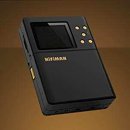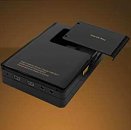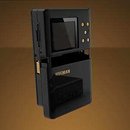Wednesday, May 13th 2009
HiFiMan Sets HM-801 PMP on Charitable Pre-order
HiFiMan has come up with a new high-fidelity portable media player, the HM-801. Unlike consumer-ended product appearance and feature-sets of PMPs such as Apple iPod, Microsoft Zune or Creative Zen, this one sits in its niche of audiophile products, emphasizing on audio output quality and support for high-bitrate lossless audio formats.
To begin with, the HM-801 uses a unit design that is uncompromising from a sound perspective, featuring a modular amplifier section and the highly regarded Burr-Brown PCM1704 DAC capable of 24-bit/96 KHz. That, coupled with the OPA627 Op-Amps, which have quite the reputation among audiophiles, is bound to give you world class sound quality on the move. Supported audio formats include WMA (including Pro and Lossless), MP3, FLAC, AAC, Ogg-Vorbis, and WAV (PCM,MS-ADPCM,IMA-ADPCM). Its storage is care of an SDHC slot, that will support SDHC cards with capacities as high as the standard supports.
The HiFiMAN PMP also features an analogue and digital line out (via coaxial SPDIF) so that you can feed your portable DAC or amplifier with a good signal. Uncompromising sound quality on the move is bound to cost big bucks and the HiFiMAN is also quite costly at $700, which is $600 at launch due to discounts that include donating $10 per purchase to audiophile website Head-Fi.org. The bigger charity of course would be that you are getting this with $100 off. And this is even without a memory solution you have to buy the SDHC card yourself.
Source:
Head-Direct.org
To begin with, the HM-801 uses a unit design that is uncompromising from a sound perspective, featuring a modular amplifier section and the highly regarded Burr-Brown PCM1704 DAC capable of 24-bit/96 KHz. That, coupled with the OPA627 Op-Amps, which have quite the reputation among audiophiles, is bound to give you world class sound quality on the move. Supported audio formats include WMA (including Pro and Lossless), MP3, FLAC, AAC, Ogg-Vorbis, and WAV (PCM,MS-ADPCM,IMA-ADPCM). Its storage is care of an SDHC slot, that will support SDHC cards with capacities as high as the standard supports.
The HiFiMAN PMP also features an analogue and digital line out (via coaxial SPDIF) so that you can feed your portable DAC or amplifier with a good signal. Uncompromising sound quality on the move is bound to cost big bucks and the HiFiMAN is also quite costly at $700, which is $600 at launch due to discounts that include donating $10 per purchase to audiophile website Head-Fi.org. The bigger charity of course would be that you are getting this with $100 off. And this is even without a memory solution you have to buy the SDHC card yourself.



24 Comments on HiFiMan Sets HM-801 PMP on Charitable Pre-order
It isn't really something top notch hi-fi, but indeed, I'd love to have one like this, but not paying $700 bucks.... more like the price of an ipod would be already enough....
$700 = Nice External DAC (much better than this mobile thing has) + Nice Headphone + Nice Sound card + Nice AMP..... so even it being a mobile device, I just can't see the reason for this crazy price....
(And PLEASE - No Pork-Chops reading the "Frequency Response Graph" CLAIMED on their packaging - that only tells how/what frequency's are RESPONDED to - It has NOTHING AT ALL to do with what sounds their speakers can reproduce. - that's why its always clearly labeled a RESPONSE graph)
I don't see the point in a portable True "High-Fi" player when you'd need a studio headset almost double the size of your own head, to actually be able to reproduce the signal range that is being output by the device.
But - I'm sure SOMEBODY has one of those headsets, and this must be the player for them.
Which is why this is indeed ridiculous, from a marketing point of view.
Although, you could make the case, like me, that the difference between the HD555 and the HD650 isn't that noticeable. But then, you'd also have to make the case that there is thus no reason to buy anything better than an iPod.
Now, the IE8's are excellent. I own them myself. But, they're not capable of using the hardware specified to its maximum output capacity. There are things like bass, treble, open-interface designs, that cannot possibly be utilized to the extent with earphones. That's beside the fact, that while the frequency response is high, it's simply not possible to compare them to top-end headphones. And so, while I don't think it's possible, even if they come up with earphones with the same factual quality, on paper, as headphones, it would still not have everything needed to provide an audiophile with the experience he/she looks for, and that's what I think this product is aiming to do.. which is my entire argument.
Anyway to get 48khz audio you need stuff from DVDs. 96khz, as i said, where the hell do you get that stuff from? Blu Ray?
This is a little off topic, but at what sample rate is a digital recording indistinguishable from analog? I eventually got used to the fact that cd's didn't sound as full as my beloved Telefunken recordings but I never like the idea.
Also, how important is frequency response when above maybe 10khz, you're not really listening to music anymore. If your a Phillip Glass fan maybe . . . but oh, that's right, we're talking about MUSIC. Hehehe. :D
I've owned 555 and own 650, yes there's difference, the problem isn't you, it's the equipment, using an ipod to compare it won't do the work for sure. :roll:
Another thing, you must have it for quite some time to "discover" the full benefit brought along.
Happened to me going from a dirty phillips sbc 250 to senn 555.... I heard little difference at the beginning, 3 or 5 weeks later.... wow... I just don't know how I could ever have lived without something like 555 is.... :toast:Look for Triple.Fi 10... seems like it's much much much better (and expensive) than most full sized headphone out there. But it won't compete for sure with the top dogs.... but it isn't a fair competition without setting a price range.You're right, you won't listen to any difference from MP3 to Flac on your 5.1 and Audigy 2 setup, but this thing is aimed for a level of quality that your setup won't give you, so FLAC starts to make sense at that point.I agree w/you.... but there's always a chance to use ASIO, although you need a sound card that can support it, so you can get bit perfect 24/96 or /192 under windows XPIt's all relative to your digital out encoding.... going from 16 to 24bit when your archive is 16 bit won't do much.Some guys rip their vinyl and a lot of material is being made in 24/96 already.don't confuse sampling rate (44/48/96/192 khz) with frequency response. 20hz-20khz they have nothing to do in a raw way.
10khz isn't the upper limit for most people, but 20khz, try yourself to download a frequency response wave (lossy formats are useless for this), and check for yourself with some sort of plug in, which frequency was the last you heard something while the wave was playing, remember that speakers and source frequency response will also play a roll on it.....
BTW although above 20khz most people just can't hear a thing, Harmonics are build up to 100khz and this is what makes every single voice and instrument unique also lower frequency 10hz interact with your body making it vibrate, you can "touch" the music.... so yes, getting flat frequency response from 1hz to 100khz is important although you can't hear must of this range. :toast:
Well, first off, I can. I hear to around 25k, and second, have you never heard of harmonics? lol